What is Perlite: Learn About Perlite Potting Soil and How To Use It To Grow Plants
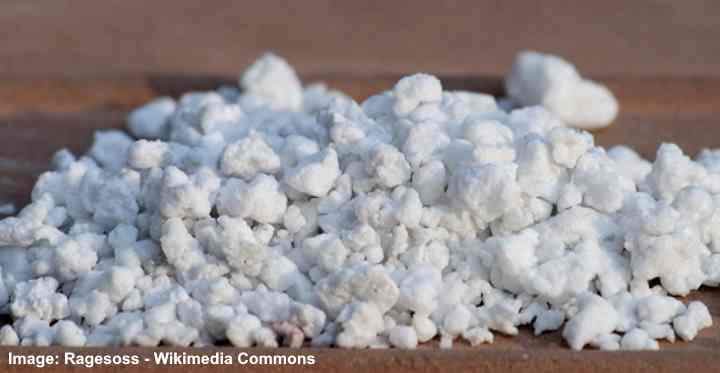
Perlite is a natural substance that helps to modify soil by making it lighter and improve its drainage. You can safely add non-toxic perlite to a potting mix if your plants need to grow in a medium that drains well. Also, these little white ball-like minerals are useful for mixing into garden soil to help aerate it. You can also grow plants in perlite or use it for rooting stem cuttings due to its ability to retain moisture.
Even though perlite is widely used for growing houseplants and in gardening, you may still wonder about this ingredient. For example, is perlite safe to use in the home? Is it suitable as a soil amendment in organic gardening? And what are the pros and cons of using perlite as a potting mix ingredient?
The article answers all your questions about using perlite in soil for growing plants.
What is Perlite?
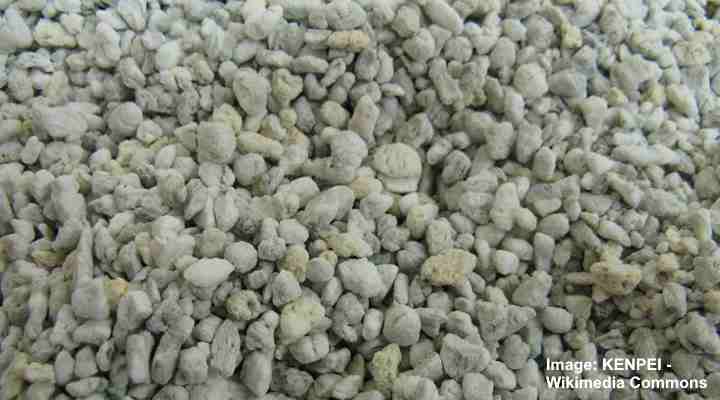
Perlite found in nature is a dark dense mineral that undergoes processing that makes it white and super light for improving soil quality
Perlite is a naturally occurring mineral that is a type of volcanic glass. In its natural form, perlite is black or dark gray and is described as an amorphous mineral—meaning that it has no structure. However, the perlite that you buy in the garden center looks different from what comes out the ground.
Many people describe perlite as Styrofoam balls as they look similar. Perlite is exceptionally lightweight and usually a bright white color. So, how did this naturally-dense mineral become the super-light soil ingredient that most gardeners—organic and traditional—love so much?
Perlite is sometimes called volcanic popcorn due to the processing techniques used to make perlite. The volcanic mineral is heated to 1,600°F (876°C), where the perlite expands and “pops”—similar to making popcorn. It can expand up to 16 times its original size. Looking under a microscope, you’ll see that horticultural perlite is extremely porous.
The reason why perlite is so useful for plant soil is that it absorbs moisture on its outside. However, because it’s lightweight and doesn’t change shape under pressure, it allows excess water to drain from pot or garden soil. Perlite is non-toxic, increases humidity, and has a neutral pH level.
What is Perlite Made of?
Perlite is essentially made of volcanic rock or glass. It is created when naturally-occurring minerals that formed as molten lava cool and trap water in them. In its natural form, perlite is a type of rock or glass. White, lightweight perlite is made by heating up the raw volcanic rock or glass. When it is heated up, the moisture in the mineral expands and turns the dense mineral into the lightweight, white product we associate with perlite.
The main ingredient in perlite is silicon dioxide—the same mineral that makes up quartz and sand. Perlite also contains aluminum oxide, sodium oxide, potassium oxide, iron oxide, magnesium oxide, and calcium oxide. It also has a water content of 3 – 5%—the reason why it can “pop.”
Uses of Perlite
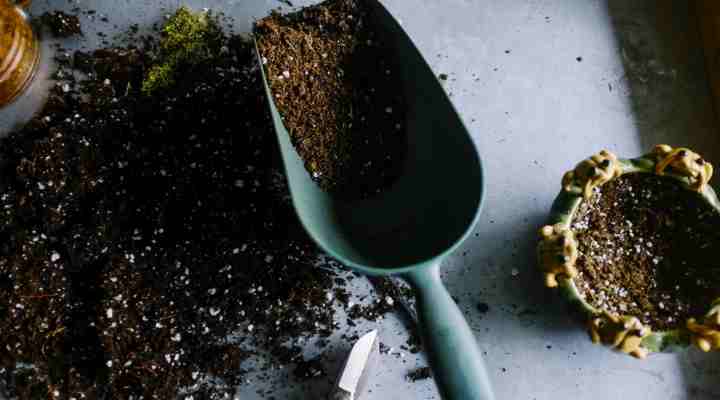
Use perlite in potting mix to improve soil drainage and aeration
The primary use of perlite is to improve soil quality so that plants grow better. Perlite is also used to help to keep soil loose, improve aeration, increase drainage, and prevent soil compaction. Perlite is also useful for growing plants using hydroponics, creating soilless mixes, or starting cuttings.
If you are using perlite to grow houseplants, you can safely use it as a soil amendment. The ingredients you need are equal parts of loam, peat moss, and perlite. This type of potting mix is perfect for growing indoor plants in containers as it holds the right amount of oxygen and moisture.
Apart from being a useful ingredient to modify soil, perlite is used in the construction industry as insulation, to make cement, and drywall boards.
What Does Perlite Do for the Soil?
Perlite is a soil amendment ingredient that can help resolve many growing issues—both with indoor and outdoor plants. A perlite soil medium is light, airy, and drains well. This type of soil helps prevent growing problems such as root rot, fungal issues, or bacterial diseases.
Here are several soil issues that perlite can help resolve:
- Perlite loosens up heavy clay soil to prevent water pooling on the surface.
- Perlite aerates any type of soil and helps roots get enough oxygen and nutrients.
- Perlite allows roots to grow easier.
- Perlite prevents plant stress because it insulates the soil from temperature fluctuations.
- Perlite doesn’t deteriorate.
- Perlite is an ideal soil medium for pots, patio plantings, window boxes, and ornamental containers.
How to Use Perlite in the Garden
Perlite is cheap and easy to use to improve soil quality in your backyard—especially if you have soil drainage issues. For example, if your garden soil is mostly clay, puddles will form, or too much moisture will stay in the ground. Using perlite to lighten garden soil helps with more than drainage—it allows plant roots to grow better.
Perlite soil amendment also allows beneficial insects and worms to keep soil healthy and fertile.
Here are some ways to use perlite for growing grass, plants, or trees in your garden.
- Vegetable and flower beds—Work in a 4” (10 cm) layer of perlite in 12” (30 cm) of soil to condition the soil for planting vegetables or flowers. If you have poor-quality ground, work in peat moss as well.
- Raised beds—Use coarse perlite to amend the soil in raised beds to prevent water pooling and improve drainage.
- Lawns—Aerate your lawn to improve drainage by spiking or plugging lawns with perlite.
- Growing trees or shrubs—Make a soil mixture using one-third soil, one-third perlite, and one-third peat moss. Dig the hole where you want to plant your tree or shrub and use the perlite soil mixture for your growing medium.
What Type of Perlite to Use in Your Garden?
The white Styrofoam-like balls that we know as perlite comes in various grades: coarse perlite, medium perlite, and fine perlite. Depending on how much you need to modify soil, you should choose the right type of perlite for your garden or containers.
Let’s look at the three different types of perlite you can buy in garden centers or stores:
- Coarse perlite—The largest type of perlite available, and it is excellent for dense, heavy soil. This kind of perlite is also suitable for soilless growing mediums such as for orchids or succulents.
- Medium perlite—The most common use of medium grade perlite is for potted plants and containers.
- Fine perlite—Use light-grade perlite if you need to root cuttings or start seeds. However, it may be difficult to find bags of this type of perlite in stores.
How to Use Perlite in Hydroponics
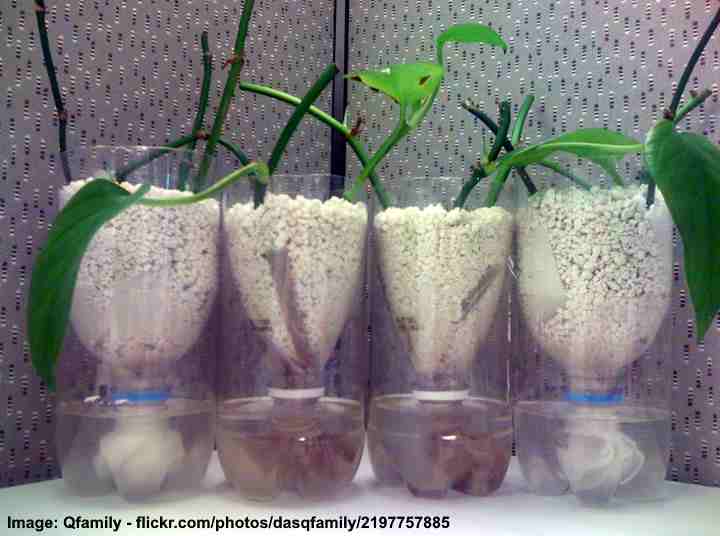
Perlite is used as hydroponic growing medium
Using these little white light rocks is also excellent to create hydroponic growing mediums. The neutral pH levels, the fact it doesn’t absorb nutrients, and its low cost mean that perlite is one of the best hydroponic solutions to use. All you need to do is fill your container with fine-grade or medium-grade perlite.
Because perlite tends to dry out quicker than some other hydroponic mediums, you can use it with other ingredients. For example, a 50 – 50 mix of perlite and vermiculite can be better for hydroponic growing than just perlite on its own.
How To Use Perlite for Rooting Cuttings
Perlite is an excellent growing medium if you need to root cuttings because it is light and retains moisture. The advantages of perlite to grow plant cuttings are that it provides hydration and also oxygenates roots. This creates the perfect light, porous medium without ever becoming soggy.
To root stem cuttings in perlite is very simple. Here are the steps to root cuttings in perlite:
- Half-fill a small pot with moist perlite.
- Gently press down the perlite granules to compact them slightly.
- Put a single plant cutting in the perlite medium.
- Fill the remaining space in the pot with moist perlite and gently press down to support the cutting.
- Place the pot in a bright, sunny spot.
- Lightly mist the perlite regularly to prevent it from drying out. However, never allow the medium to become too wet or soggy.
- Once the cuttings have rooted, transfer to a new, larger pot that contains the appropriate potting mix.
Another way to use perlite to root cuttings is in a Ziploc plastic bag. To root cuttings this way, this is what you should do:
- Fill a Ziploc bag with moist perlite until it is one-third full.
- Place your cuttings in the perlite, fill the bag with air, and then seal it.
- Put the bag in a bright location, but protected from direct sunlight.
- Check the rooting bag every so often to make sure the perlite is still moist.
- Once your cuttings have rooted, transfer to a pot for growing.
Advantages of Perlite
Perlite has many advantages when it comes to growing houseplants or amending garden soil. The fact that it’s a natural, sterile substance means that organic and traditional gardeners can use it safely. What other reasons are there to use perlite soil mixtures? Here are five benefits of perlite:
1. Perlite is reusable
Perlite doesn’t break down in the soil like other soil amendment ingredients. It keeps its form, and you can reuse it when you repot your houseplants. The only time when it’s not advisable to reuse perlite is if your plant had a disease problem. Although you can sterilize perlite, it is best to discard all the diseased soil along with the perlite and start again.
2. Perlite is neutral in pH
Adding perlite to soil doesn’t alter its chemical makeup. So, perlite is an excellent choice for improving soil texture if you need acidic soil or alkaline soil. Perlite takes on the acidity or alkalinity of the type of soil it is in.
3. Perlite doesn’t absorb nutrients
Another advantage of perlite is that it doesn’t rob plants of nutrients in the soil. Some soil amendments such as coco coir, rock wool, or pebbles can absorb soil nutrients. So, to reuse perlite, you just have to rinse it and then use it again.
4. Perlite is inexpensive
The low-cost of perlite makes this product popular with gardeners and houseplant owners. Of course, if you only have a few houseplants, the cost may not be too much of an issue. However, if you need to improve soil texture in your yard or care for many indoor plants, the cheap cost of high-quality perlite is a great advantage.
5. Perlite aerates soil and improves drainage
One of the most significant advantages of using perlite in soil is that it helps prevent many growing problems. Perlite does a great job of improving soil drainage, helping to oxygenate the ground, and preventing soil compaction.
Disadvantages of Perlite
Are there any disadvantages when using perlite indoors or in your yard? There are a few ecological concerns associated with perlite use.
1. Perlite is from a non-renewable source
Perlite is mined from a resource that isn’t renewable. Although there are ample supplies—enough to last hundreds of years—when it’s gone, it’s gone. Of course, the fact that perlite is reusable may offset this disadvantage.
2. Perlite dust could be hazardous
One concern with using perlite is that the dust can cause irritation and isn’t great for your respiratory system. Some types of high-grade perlite are sold as “virtually dust-free.” However, when using perlite to pot houseplants to modify garden soil, always wear a protective mask and goggles.
3. Not suitable for all plants
Perlite is generally regarded as one of the best soil amendment ingredients. However, not all plants thrive when perlite—especially coarse perlite—is added to the soil. Plants with vigorous root systems such as chives or mint may not grow as well in perlite.
Perlite vs. Vermiculite
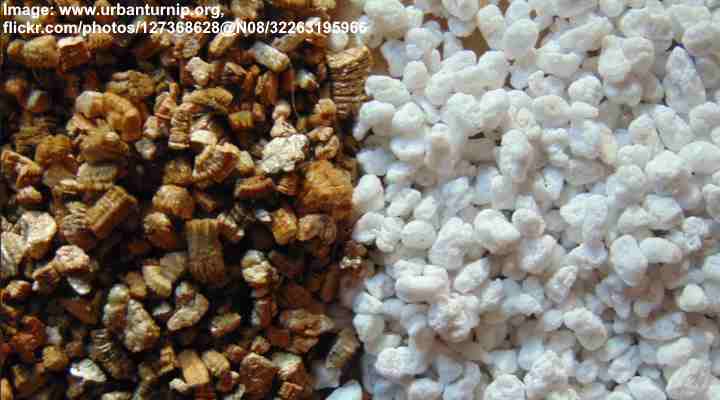
Vermiculite (left) and perlite (right)
Perlite and vermiculite are both natural products and used soil as additives to help aerate soil. However, there are differences between the two. Vermiculite tends to retain more moisture and is not the best choice for well-draining potting mixes. However, vermiculite may be better than perlite for plants that grow best in damp soil.
Perlite vs. Pumice

Pumice volcanic rocks
Perlite and pumice are substances that are derived from molten lava. Both materials are porous and help to boost drainage in soil. Many gardeners recommend using pumice rather than perlite for tall plants because it weighs more. When it comes to price, perlite is cheaper than pumice.
Does Perlite Break Down?
Perlite doesn’t deteriorate in the soil like ingredients such as bark, coco coir, or compost. When you work perlite into garden soil or houseplant soil, it remains there. So, it will continue to help retain essential moisture and aerate soil or lawns until you remove it.
Is Perlite Organic?
Perlite is safe to use in organic gardening because it is entirely natural and not a synthetic material. According to the United States Department of Agriculture (USDA), perlite is on the list of substances approved for organic farming. There is no chemical processing involved in making perlite (1)
Sometimes confusion arises if perlite is organic or not due to it being an inorganic material. However, this refers only to the fact that perlite is not from a living substance. It doesn’t contain carbon, so it is called non-organic matter.
Can You Grow Plants in Just Perlite?
Perlite is suitable for growing plants without any soil. As a soilless growing medium, perlite retains some moisture and also allows oxygen to get to the roots. However, perlite tends to float in excess water, so it may not be ideal for all plants. If you want to use perlite as a soilless growing medium, mix it with peat moss.
Is Perlite Harmful?
Perlite is not toxic and mostly contains silica, which is also the main component of sand. You can safely handle perlite granules when potting or repotting plants. Perlite has many uses in agriculture and construction.
Studies into any harmful effects of perlite concluded that it doesn’t pose a risk to the general population. However, perlite dust is described as a “nuisance dust.” So, breathing in the dust or ingesting perlite is not advisable. To be safe, always wear a face mask when handling perlite. (2)
Where to Buy Perlite
You can buy perlite in many DIY stores or garden centers. You may also find it in stores that specialize in hydroponics. Of course, many online stores sell horticultural perlite in large or small quantities. You can buy perlite in Amazon here.
Related articles:
- Great Mulch Options (Also Cheap or Free)
- Homemade Weed Killers: Natural, Safe & Non Toxic
- Natural Ways to Get Rid of Houseplant Pests
